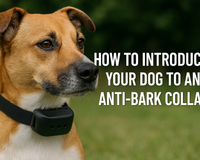Does your dog jump on you when you walk in the door? Or when you get the leash for a walk?
You aren't alone. Jumping is a natural instinct for dogs, but the good thing is, it's something that you can improve with training!
Here are four easy-to-implement tips for you. Your dog will have all four paws planted in no time.
time.
Do Dogs Grow Out of Jumping?
Unfortunately, dogs don't grow out of the "jumping on you" habit.
If you let your puppy jump up on you when they are little and give them attention and affection for doing so, they will only grow into this habit.
Puppies who frequently socialise with well-trained adult dogs are more likely to stop this behaviour and only jump on other dogs during playtime.
The best way to prevent your dog from jumping on you is to train your dog.
Why You Need to Train Your Jumping Dog and Why Jumping is Bad for Dogs?
Jumping puts a lot of pressure on your dog's joints. Like humans, dogs can develop arthritis (inflammation of the joints), and some studies show that as many as 65% of all dogs will develop arthritis in their lifetime.
A jumping dog can also potentially hurt someone. It may seem harmless if you have a small dog or puppy, but if you have a large dog, they could potentially knock someone over!
The jumping may also frighten someone who has previously had traumatic experiences with dogs, worsening their anxiety.
It's considered bad manners to let your dog jump on anyone.

How Do You Train a Dog Not to Jump on You?
It will take consistency and patience to stop your dog from jumping. You'll also need to enlist the help of some friends to train and test your dog to stop jumping on every person that enters a room.
1. Use a Command
To prepare: ask a friend (or loved one) for their time, and make sure you have a leash on your dog.
Ask your friend to walk into your house and let your dog react. As soon as your dog jumps on your friend, gently tug on their leash and use the command "off". This will teach your dog to keep their paws planted on the ground.
Keep practising this command. Over time, as you practice, slowly reduce tugging the leash until you don't need it anymore. Your dog will either stop jumping completely or will obey the "off" command.
2. Reward
Make sure you reward your dog with something they love every time you practice the "off" command. The treat will encourage your dog to keep repeating the behaviour if they know something special happens afterwards.
3. Be Consistent
Ensure you (and your household) are entirely consistent with your "off" command. Your jumping dog will learn much faster by practising regularly and consistently. If your dog jumps when you come home from work, spend a few minutes each day coming and going to practice.
4. Add Another Command (optional)
Once your jumping dog keeps all four feet planted for a few seconds, start asking them to sit.
Walk through the door, give the command "sit", and reward your dog with a treat when they do.
This will take lots of practice and consistency, but with plenty of repetition, your dog will soon start sitting when you walk through the door.
By asking them to sit, you're redirecting them to more appropriate behaviour. Whenever your pup sits, make sure to give them an excellent reward.
Dogs behave best when we tell them what to do, instead of what not to do. You can also direct them to complete a different command.
For example, you could add "rolling over" so they are on their back. Then your reward for your pup could be a tummy rub.

Use a Dog Training Collar
If your dog is very excited and it's hard to get them to focus, try using a remote training collar. With the remote control, you can send a distraction to your dog when you need them to focus. Once they pay attention to your commands, you can reward them.
What Not to do with a Jumping Dog
Never use your knee to hit a jumping dog in the chest. This is extremely dangerous and could seriously injure your dog.
A human knee to a dog's chest may be interpreted as playing by the dog. The dog's response will be to continue jumping because it thinks this is a game, and now you've reinforced the behaviour you're trying to discourage.
The same goes for yelling or pushing your jumping dog; it'll be interpreted as play and reinforced. By engaging physically with your dog (and potentially hurting them), they may make negative associations which leads to fear-based aggression. Fear-based aggression is a much more challenging issue to fix.
Final Jumping Dog Thoughts
Your jumping dog can be a real nuisance to others. You can train your dog not to jump up on people or yourself with the techniques listed in this article.
If you experience problems teaching your dog from jumping on you, we recommend you seek the advice of a professional dog trainer.
If you want an option to capture your dog's attention, try using a training collar. These devices will catch your dog's attention so you can give them a command.
Browse our range of dog training collars or if you're unsure which device is right for your dog, give our friendly customer service team a call.









